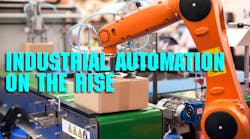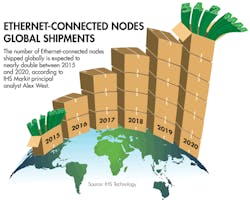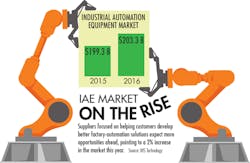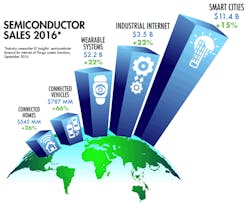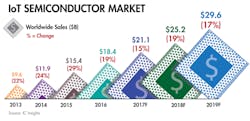This file type includes high-resolution graphics and schematics when applicable.
Demand for networking, “edge-computing” solutions, and an overall drive to glean more—and better—data from industrial equipment and systems is creating new opportunities throughout the supply channel, especially for suppliers of electronic components and related systems. As the smart-factory movement and the Industrial Internet of Things (IIoT) take hold, suppliers point to growing demand for more complex equipment and machinery—and the electronic components required to build it—as a prevailing technological trend in manufacturing today.
“The IoT really is [about] connectivity from what’s on the plant floor to how you get data outside the plant floor—or from the outside in—quicker, faster, to make easier decisions,” says Dan Shaughnessy, director of product sales for Kaman Automation, which provides industrial solutions to original equipment manufacturers (OEMs), industrial production plants, and infrastructure facilities. “It’s about improving predictive and preventive maintenance [for example]. And it all comes down to data.”
And although Shaughnessy says many industrial customers are still trying to “figure out” what the IoT—or, more specifically, the IIoT—means to them, they seek advice on the best components and equipment that will create greater connectivity, leading to demand for sensing, networking, and computing products and systems. Here is a look at what Shaughnessy and other suppliers of automation solutions and electronic components say are driving the trend.
Networking Solutions
The primary goal for myriad industrial and manufacturing customers is connecting the equipment on the plant floor to a network that can monitor, measure, store, and retrieve data. Shaughnessy explains that doing so helps companies yield dividends in the form of better information to make predictive maintenance decisions, repair or replace decisions, and so forth.
For many customers, the first step is ensuring that every piece of equipment on the plant floor has an Ethernet connection and can push or pull data from the system via software. The various protocols for doing so fluctuate from customer to customer—and even within plants—which is why the networking aspect of automation often plays the largest role in a job today.
“We spend a lot of time with customers on the networking side of things, talking about how much bandwidth they need, and how to segment networks,” says Shaughnessy. “We also talk about remote connectivity and how you safely get into your systems from the outside. The next big portion [of this] is how you house the data you want to mine from these elements.”
These are issues that continue to evolve, notes Alex West, a principal analyst with research firm IHS Markit, echoing Shaughnessy’s point about the growth in Ethernet technology, in particular. West says the number of Ethernet-connected nodes shipped globally is expected to nearly double between 2015 and 2020—from 29.6 million to 54.2 million—continuing a trend that has been developing over the last 10 years. Compared to traditional fieldbus technology, Ethernet devices can be IP-addressable, the technology offers higher bandwidth, and can be more seamlessly integrated throughout an organization, making it “the networking solution of choice” when it comes to enabling IIoT solutions, adds West.
“Increasingly, there’s a transition to using Ethernet,” he explains. “Fieldbus is still growing, but at a far slower rate.”
A similar story unfolds when it comes to data storage, particularly as it relates to the cloud. Shaughnessy says more and more customers are looking at cloud-based solutions for data storage—particularly smaller and midsized companies that can’t afford the cost of complex IT structures. West notes that companies large and small are still divided when it comes to the cloud: Many are still concerned about data security, while some have become comfortable with housing select data outside of their company’s walls.
“Organizations are becoming more educated and more comfortable with how they can use the cloud to support their business,” explains West, pointing to greater visibility across multiple facilities and the supply chain, as well as the opportunity to leverage more complex algorithms and greater computing power. “That’s going to be one of the interesting stories—how companies become comfortable placing more data on the cloud in the future.”
Homing in on Components
TTI Inc. is another supplier focused on helping customers add networking and data-gathering capabilities to equipment and devices. Brian Wellhouse is the company’s supplier marketing manager for sensors, a new and expanding category for this distributor of passive electronic components. In the case of OEMs, identifying customers’ needs to get to market faster, with less downtime and while creating a more efficient product, is paramount—especially when you can show them how to do so without completely redesigning a product or piece of equipment.
“That’s how we’ve really led with sensors,” explains Wellhouse. “[Customers] can add features to their old device without having to change a majority of the [printed circuit board].”
Wellhouse points to growth in wireless connectivity as an example. He says one of the most prevalent customer trends is to add networking and data to existing devices or create new sensor networks. He notes advances in pressure transducer technology that can accommodate wireless modules, enabling remote monitoring of systems.
Heating, ventilating, and air conditioning systems represent one specific case. By removing additional components and cabling, data can be transmitted wirelessly to a data-acquisition system. For instance, incorporating connectors with Bluetooth technology eliminates the need to source the cable that would typically transmit data from the system.
Whether developing wired or wireless solutions, however, suppliers emphasize the importance of gathering intelligence in today’s factory environment. And they also point to the opportunities available across the growing industrial automation equipment market—valued at $199.3 billion in 2015 and expected to hit $203.2 billion this year, according to IHS Markit.
“The fact is, if your device or piece of equipment on the floor is standalone, you’ll never get anything out of it at all,” says Kaman’s Shaughnessy. “Every device that you’re going to put somewhere—every device that will have the ability to gather intelligence—needs to be on a backbone of some type that allows it to produce data or have data pulled out of it.”
Sensors and Remote Connectivity
Because efficiency is a top concern in the industrial market, it also is a driving force behind the growth of the Industrial IoT. In a 2016 report, “Smart Technologies Impacting Industrial Market Dynamics,” IHS researcher Bill Morelli explained it this way: “In the industrial market, many of the strategies for more efficient manufacturing and commerce include demand for remote communications, monitoring, and control. This trend is driving the growth of integrated intelligence, sensor networks, asset tracking, internet connectivity, M2M communications, and energy measurement and management.”
Remote system monitoring is an important step in that direction—and a factor driving advances in sensor technology at the component level. TTI’s Wellhouse suggests combination sensors—or “sensor fusion”—as a key industry trend. Customers are demanding a wider range of functions out of their sensors. One example, he says, are sensors that once gauged only temperature but can now sense humidity output as well—at a good price point. Street lighting is another example; customers are adding sensors to lighting that not only measure energy use, but count cars and gather other traffic-flow information. The drive is toward fewer components that gather more data.
As a distributor, one of the greatest challenges faced by TTI involves educating customers on the wide range of solutions available to achieve a particular result, adds Wellhouse. He says as many as four to five different technologies can do the same thing, at widely varying price ranges.
“Much of our work has been educating engineers on different technologies and solutions based on the sensing need they have for the application,” explains Wellhouse. “We’re supporting design and making sure engineers are aware that there are multiple solutions for a single problem.”
Aiden Mitchell, vice president of IoT sales for Arrow Electronics, agrees and emphasizes growing demand for sensing at the “edge”—that is, embedding more sensors at the device level. This underscores the growing importance of data, says Mitchell, noting that ubiquitous sensing is giving customers the real-time execution they need to generate new and better information to improve operations.
“In components, the biggest opportunity is at the edge. On the sensor side, we’re seeing sensor unit growth and low-power wireless as the two fastest growing technology areas. That growth is only matched by embedded computer solutions—board-level and box-level solutions,” he explains. “More and more, the value is shifting to the data. Companies run on data either because that’s what’s going to drive their efficiency, or maybe because it’s going to drive their new revenue model. Either way, it’s all about the data.”
Edge Computing Takes Hold
Like the IoT itself, trends surrounding IoT component technology are also connected. Mitchell’s point about putting more sensing technologies at the “edge” of a process is part of a separate trend toward “edge computing.” Both Arrow and electronic components distributor Avnet Inc. say that trend is beginning to drive growth in the segment and has considerable long-term potential.
Essentially, edge computing pushes computing technology away from centralized networks and toward the source of data by using a variety of devices—laptops, tablets, cell phones, and sensors, to name a few. Avnet’s Eric Williams describes it as “pushing the processing mode out to the edge.” And he says it’s all about data and efficiency.
“Edge computing allows you to manage some portion of the workload so you don’t have to stream that information back up to the cloud 24/7,” explains Williams. “Suppliers and customers are looking for edge-based solutions—to create processing at the edge.”
Once again, lighting is a prime example. In the case of street lighting, an edge-based solution tracks information at the lighting source and sends back only necessary data, such as when a particular lumen level is reached that indicates the need for service. The end result is more focused data generation that allows organizations—businesses, municipalities, and others—to make better decisions.
“Components and hardware are still vital, but it’s all about what you need [in order] to generate data,” adds Mitchell. “It’s about sensing embedded in that edge device. Then it’s about the mobilized, embedded compute options…all of this allows you to predict a lot more accurately what’s going to occur.”
Growth Ahead
However you look at it, the IIoT is ripe for growth. Recent industry data predicting sales growth in semiconductors for IoT-related systems bears this out. Industry researcher IC Insights said this fall that IoT semiconductor sales will rise 19% this year to $18.4 billion—with industrial internet applications rising 22% to $3.5 billion. Connected cars, homes, wearables, and smart cities also will drive that growth.
“It’s a really fun and interesting time in the industry,” says Mitchell. “There are still challenges in many other markets. But one thing is for sure: We’re seeing IoT really drive growth.”
